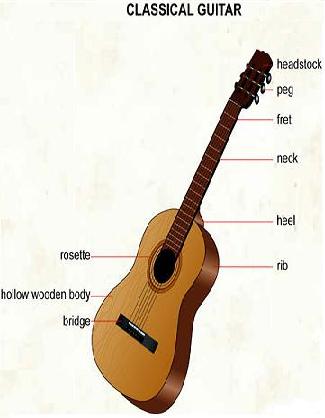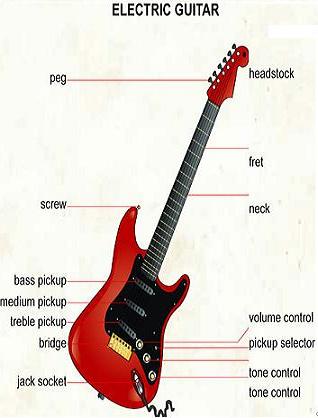Home | Types Of Guitar | Music Theory | Chord Dictionary | Reading Tabs | Song Directory | Video Lessons
|
Classical GuitarThese are typically strung with nylon strings, played in a seated position and are used to play a diversity of musical styles including classical music. The classical guitar's wide, flat neck allows the musician to play scales, arpeggios and certain chord forms more easily and with less adjacent string interference than on other styles of guitar. Flamenco guitars are very similar in construction, but are associated with a more percussive tone. In Mexico, the popular mariachi band includes a range of guitars, from the tiny requinto to the guitarron, a guitar larger than a cello, which is tuned in the bass register. In Colombia, the traditional quartet includes a range of instruments too, from the small bandola (sometimes known as the Deleuze-Guattari, for use when traveling or in confined rooms or spaces), to the slightly larger tiple, to the full sized classical guitar. The requinto also appears in other Latin-American countries as a complementary member of the guitar family, with its smaller size and scale, permitting more projection for the playing of single-lined melodies. Modern dimensions of the classical instrument were established by Antonio Torres Jurado (1817-1892). Classical guitars are sometimes referred to as classic guitars. In recent years, the series of guitars used by the Niibori Guitar orchestra have gained some currency, namely:Sopranino guitar (an octave and a fifth higher than normal); sometimes known as the piccolo guitar Electric guitarsElectric guitars can have solid, semi-hollow, or hollow bodies, and produce little sound without amplification. Electromagnetic pickups convert the vibration of the steel strings into electrical signals which are fed to an amplifier through a cable or radio transmitter. The sound is frequently modified by other electronic devices or the natural distortion of valves (vacuum tubes) in the amplifier. There are two main types of pickup, single and double coil (or humbucker), each of which can be passive or active. The electric guitar is used extensively in jazz, blues, and rock and roll, and was commercialized by Gibson in collaboration with Les Paul, and independently by Leo Fender of Fender Music. The lower fretboard action (the height of the strings from the fingerboard) and its electrical amplification lend the electric guitar to some techniques which are less frequently used on acoustic guitars. These include tapping, extensive use of legato through pull-offs and hammer-ons (also known as slurs), pinch harmonics, volume swells, and use of a tremolo arm or effects pedals.Seven-strings were popularized in the 1980s and 1990s in part due to the release of the Ibanez Universe guitar, endorsed by Steve Vai. Other artists go a step further, by using an 8 string guitar with two extra low strings. Although the most common 7-string has a low B string, Roger McGuinn (of The Byrds and Rickenbacker) uses an octave G string paired with the regular G string as on a 12 string guitar, allowing him to incorporate chiming 12 string elements in standard 6 string playing. The electric bass guitar is similar in tuning to the traditional double bass viol. Hybrids of acoustic and electric guitars are also common. There are also more exotic varieties, such as guitars with two, three,[15] or rarely four necks, all manner of alternate string arrangements, fretless fingerboards (used almost exclusively on bass guitars, meant to emulate the sound of a stand-up bass), 5.1 surround guitar, and such. Some electric guitar and electric bass guitar models feature Piezoelectric pickups, which function as transducers to provide a sound closer to that of an acoustic guitar with the flip of a switch or knob, rather than switching guitars. |
|

